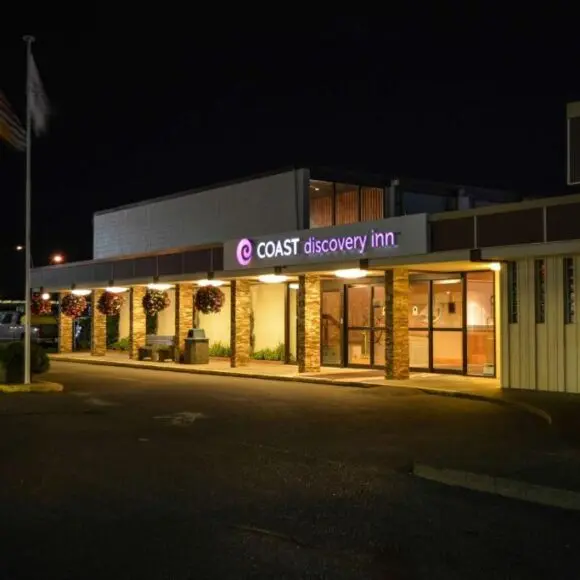Hotel Metchosin Beach House

Metchosin Beach House
Hotel Metchosin Beach House reviews
Looking for a great place to stay in Victoria? Book Metchosin Beach House; rated and is available from CAD $ 162. Metchosin Beach House is conveniently located near ferry terminals, and can be booked directly with Trivago.
📍 Address Metchosin Beach House
5191 William Head Road, V9C 4H5, Victoria, Canada
FAQ
What parking options are available at the Duke Point ferry Vancouver terminal?
The Duke Point ferry Vancouver terminal offers various parking options for travelers. Whether you’re planning a short trip or an extended stay, you’ll find suitable parking solutions. For detailed information regarding parking availability and fees, it is recommended to review the Duke Point terminal parking information. Parking at the terminal is a pay parking system, and during busy periods, parking spots can fill up quickly, so it is best to arrive with time to spare.
How much does it cost to take a vehicle on the Horseshoe Bay to Departure Bay ferry Vancouver crossing?
The cost of taking a vehicle on the Horseshoe Bay to Departure Bay ferry Vancouver crossing is determined by several factors, including the size and type of your vehicle, as well as the time of year. To get precise pricing, it’s best to check the Horseshoe Bay to Departure Bay vehicle fares. Fares typically include a base rate for the vehicle and additional charges for each passenger. During peak season, especially summer months and holiday periods, fares may be higher. It’s also worth noting that fuel surcharges can be added to the total cost.
Ferry Vancouver
Ferry travel tips for first-time visitors include arriving early, bringing layers for changing weather conditions, and planning ground transportation in advance. Understanding terminal layouts and boarding procedures reduces travel stress. Experienced ferry travelers recommend booking accommodations on Vancouver Island in advance, especially during peak season periods.
Cargo and freight services operate alongside passenger ferries, supporting Vancouver Island’s economy and supply chains. Commercial vehicles transport everything from fresh produce to building materials. This integrated transportation system maintains Vancouver Island’s connection to mainland markets and services.
Multi-day Vancouver Island itineraries often begin with ferry travel from the mainland, allowing tourists to explore the island’s diverse regions. Popular destinations include Victoria’s Inner Harbour, Tofino’s surf beaches, and the wine regions of the Cowichan Valley. Ferry connections enable comprehensive island exploration combining urban and wilderness experiences.
Environmental initiatives by ferry operators focus on reducing emissions and protecting the sensitive marine ecosystem of the Salish Sea. Modern vessels incorporate fuel-efficient technologies and waste reduction programs. Passengers can contribute to environmental protection by following onboard recycling and conservation guidelines.
Cultural experiences begin during ferry travel with onboard art displays featuring local Pacific Northwest artists. Indigenous cultural elements appear in vessel names, artwork, and interpretive displays. These features introduce visitors to the rich cultural heritage of Vancouver Island and coastal British Columbia.
Fuel and vehicle services are available at some ferry terminals, allowing travelers to prepare for their Vancouver Island adventure. Terminal locations often feature gas stations, convenience stores, and automotive services. Pre-trip vehicle inspections ensure safe travel on Vancouver Island’s diverse road conditions.
Emergency procedures and safety protocols ensure passenger security throughout ferry crossings. Modern vessels feature comprehensive safety equipment and trained crew members. Regular safety drills and equipment inspections maintain the highest safety standards for all passengers and vehicles.
Duke Point near Nanaimo provides an alternative ferry terminal with connections to Tsawwassen, offering a more southern approach to Vancouver Island. This route is particularly popular with commercial vehicles and RV travelers seeking to avoid downtown traffic. The Duke Point terminal provides easy access to the Island Highway and central Vancouver Island destinations.
Connecting transportation from ferry terminals includes public transit, rental cars, taxis, and ride-sharing services. Victoria’s Swartz Bay terminal connects to downtown Victoria via public bus service. Nanaimo terminals provide access to Island-wide transportation networks for exploring Vancouver Island’s diverse attractions and natural areas.
Ferry services to Vancouver Island provide the essential connection between mainland British Columbia and one of Canada’s most beautiful destinations. BC Ferries operates multiple routes linking the mainland to various ports on Vancouver Island, offering travelers spectacular scenic journeys across the Salish Sea. These ferry crossings are not just transportation but memorable experiences showcasing the stunning Pacific Northwest coastline.
Seasonal variations significantly affect ferry operations, with summer bringing increased frequency and capacity to handle peak tourist demand. Winter schedules may have reduced sailings, while spring and fall offer moderate crowds with pleasant weather. Holiday periods require advance planning due to extremely high demand for popular routes.




